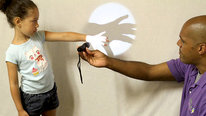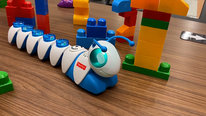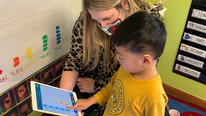- Gabriela Rose
- http://www.storytimestem.com
- Curriculum Developer
- Storytime STEM-packs
- https://storytimestem.com/
- Allegheny Intermediate Unit
- Michele Burgess
- https://storytimestem.com/
- Curriculum Developer
- Storytime STEM-packs
- https://storytimestem.com/
- Allegheny Intermediate Unit
- Michael Fierle
- http://www.storytimestem.com
- Curriculum Developer
- Storytime STEM-packs
- https://storytimestem.com/
- Allegheny Intermediate Unit
- Amanda Loughner
- STEAM Teacher
- Storytime STEM-packs
- https://storytimestem.com/
- Derry Area School District
- Corinne Murawski
- https://storytimestem.com/
- Curriculum Developer
- Storytime STEM-packs
- https://storytimestem.com/
- Allegheny Intermediate Unit
- Keith Trahan
- Visiting Assistant Professor of Practice and CEAC Interim Director
- Storytime STEM-packs
- https://storytimestem.com/
- University of Pittsburgh
Public Discussion
Continue the discussion of this presentation on the Multiplex. Go to Multiplex












Gabriela Rose
Curriculum Developer
Thank you for taking the time to watch our video! We are thrilled to be here and exchange ideas with others. We would love to hear your feedback on any aspect of our project. We are especially interested the following questions:
Jasmine Maldonado
Hi Gabriela and Team, Great video! At the NY Hall of Science, we also do a lot of literacy-based engineering for early childhood. We find that popular storybooks such as the Pigeon and Pete the Cat series have endearing characters that children resonate with. When we pose a design challenge where these characters need some sort of "help", this narrative becomes a hook and children are highly motivated to problem solve. It is truly fascinating! We too are thinking about ways to measure impact. Currently, we've been doing informal observations during prototyping sessions with PreK classrooms as well as photo/video documentation. Looking forward to reading the suggestions/resources in this strand. Hope we can collaborate sometime!
Gabriela Rose
Curriculum Developer
Hi Jasmine,
Thank you for connecting. You are so right. It is very neat to see the children get so engaged when they want to help a character in the story.
I like the idea of photo/video documentation with an evaluation focus, That also opens the possibility of asking the children a question and then capturing their answer and video.
We would love to chat more and are always open to collaboration.
Kathy Renfrew
Education SPecialist
Thanks for sharing your project with us. As an elementary educator interested in the leverage that both literacy and comptuational thinking hold for potentially increasing time for science for our yougest learners, I know I want to know more about your project. I would love to know what book/story children and teachers feel is the most impactful on the child's vision of him or herself as a scientific thinker, mathematician, engineeer, etc.
I also see that you are currently talking about the impact of the project with teachers. I am wondering if you have considered talking with the children themselves to get more direct data. Have you considered doing a pre/post interview with the children? I am thinking one early in the year prior to Storytime STEM being implemented and one the end of the year.
Some of my new favorite picture book is Violet's Music, What's in Your Pocket? Steven Curry: The Boy Who Never Gave Up, Building Zaha, The World is Not a Rectangle. I could go on and on and would love to talk/learn more about this project.
Michele Burgess
Gabriela Rose
Curriculum Developer
Thank you for your feedback and suggestions. We see the children really get into those stories where they act out part of the story on the mat, as you see when they play hide and seek with Dragon and Girl. They also are very engaged in any of the engineering design tasks, such as helping Otter by creating and testing a parachute for a soft landing in the Storytime STEM-pack Otter in Space.
Using a pre-and post-interview with the children is a great idea. We could ask the teachers to do a short interview at the beginning and end of the year with our next grant cycle. Does anybody have any interview questions that they successfully used with young children?
Thank you for the picture book suggestions!
Latrenda Knighten
Mathematics Content Trainer
Thanks for sharing your project. Your project involves some of my favorite things - literature, STEM, and my first love - teaching early childhood students! I appreciate your attention to the importance of gathering data to measure the impact of your project. Have you thought of using an interest survey/interview with the students before and after engaging in the project as a tool to measure students' interest? You could use a similar process to measure student content knowledge of STEM topics and computer science or use one survey as a measurement tool for all components.
You also mentioned that you've implemented your project with more than a thousand formal and informal educators. Could you provide more details about the educators and student populations who participated in the project?
You mentioned that your team is actively looking for additional literature books to use for your project. This link https://padlet.com/georginarivera123/2ygfo12jus... is to a padlet created by a brilliant friend, Georgina Rivera and may include some titles of interest.
Thanks again for sharing and for your work with young children.
Michele Burgess
Gabriela Rose
Curriculum Developer
Thank you for taking the time to provide feedback to us. We agree, literature, STEM and young children is a perfect combination!
You also suggest the pre-post survey/interview. That is a great idea. Since the children are so young, we would probably have to find a way for the survey/interview answers to be asked and recorded by an adult. Is anyone aware of an existing instrument that has age-appropriate content questions for STEM+C?
Our project originated through collaboration with public libraries that were looking for STEM professional development to integrate science into their summer reading club. The children’s librarians told us that they needed materials that were fun and engaging for kids, easy to use with minimal preparation time, and aligned to standards. We then found that other groups of educators had the exact same needs and loved our STEM-packs. We work with public libraries, Head Start classrooms and preschools. On the elementary school side, Storytime STEM-packs are being implemented in STEAM programs, by classroom teachers K-2, the school library, and after-school and summer programs.
Thank you so much for sharing the padlet!
Latrenda Knighten
Latrenda Knighten
Mathematics Content Trainer
Thanks for your prompt and comprehensive response! I LOVE that your project was initiated through collaboration with public libraries. I wish more people would take advantage of the many resources available through collaboration with local libraries. One summer a colleague and I traveled to libraries in our state to provide hands-on math activities to young children based on the PBS Cyberchase program and we had a ball!
Corinne Murawski
Janet Stramel
Thank you for sharing this! I was so happy to see the work with elementary students.
Gabriela Rose
Curriculum Developer
Thank you! We love our work!
Margo Murphy
Science Instructor
I appreciate that you have found other important outcomes, beyond literature and CS, such as learning to collaborate with each other and talk about their ideas through this project. I also love the versatility of the storyboard and bee-bot to connect with a variety of stories. You have many years of of what seems like a pretty polished product, other than grant funding, are there other plans for scaling up? And wondering whether you have been able to track any students that have continued with CS interest beyond this project?
Gabriela Rose
Curriculum Developer
We are so glad you mention the collaboration and talking through ideas. We feel that this is foundational to not only learn STEM and computer science, but also to become a happy, successful, and empathetic person and member of the community.
Yes, the storyboard gives the students the opportunity to extend the story and become an actor in the story.
This is an intriguing idea to try to follow some of the students track their interest in CS beyond the project. We need to think about how we might be able to make that happen without a long-term grant.
And, yes, we are looking to scale up, with and without grant funding. We are privileged to have been selected by the Iowa Governor’s STEM Advisor Council as one of the providers in the STEM Scale-up program for a second year. Working with the Iowa educators has been great, and we are looking to find other states that might have similar programs for their educators.
Margo Murphy
Science Instructor
I am really happy to hear you have some scale-up support within your state. Do you have capacity to expand beyond Iowa? If so, do you have an idea of a classroom cost if other states or even individual schools were interested in joining?
Gabriela Rose
Curriculum Developer
We are very grateful to the folks at Iowa Governor’s STEM Advisor Council for their partnership, and yes we are looking for other states and organizations to partner with us to further scale up. In 2019/20 we were funded by the PA Department of Education in our home state of Pennsylvania via a PAmart grant. We also co-designed Storytime STEM-packs focused on Energy education for PreK-2 learners with our friends at Clean Energy Bright Futures, Bonneville Environmental Foundation (CE), based in Oregon. Through that partnership, several organizations in different states have received Storytime STEM-packs, including Oregon, California, and Arkansas. In addition, we’ve worked with the wonderful people at the West Sound STEM network to bring Storytime STEM-packs to teachers in Washington state. We customize the classroom packet for each of our partners. For the PAsmart grant, we focused on computer science and STEM, for CE on energy education, and for the West Sound STEM network, on mathematics, science, and engineering design. Accordingly, the cost for a classroom varies, depending on how many Storytime STEM Adventures and/or Storytime STEM-packs they wish to implement. Many individual schools and organizations have implemented Storytime STEM-packs by ordering directly from our website. We are excited for every opportunity to bring more STEM-packs to more kids. You can also look at our website and see all Storytime STEM+C Adventures and Storytime STEM-packs we currently offer. Please contact us directly if you are interested in partnering
Denice Blair
This is so exciting! The integration of literature with the problem solving looks like a great way to get students engaged. As a museum educator, I focus a lot on helping students of all ages develop their own historical and science questions to investigate. It sounds like the Storytime STEM-packs really support students in asking and answering their own questions.
Gabriela Rose
Curriculum Developer
Thank you, Denice. We always try to provide the opportunity for kids to ask and answer their own questions. Situating the task in context of the storybook and connect it to their own lives helps with that. There are some museums that have received Storytime STEM-packs as part of the Iowa STEM Scale-up funding. We would love to work with more museums.
Jennifer Kidd
I love the idea of turning Bee-bot into a dragon. I like the possibilities for adding engineering to computer science by enhancing Bee-bots capabilities (e.g. what could he "wear" that would allow him to rescue someone?). You are so right about the three criteria for in-service teachers: 1) fun & engaging 2) easy to implement and 3) aligned with standards. We are seeing this but didn't have your nice checklist. Thanks for making it so clear!
Gabriela Rose
Curriculum Developer
Thank you, Jennifer. We really like your idea of asking the children to engineer enhancements for Bee-Bot to solve problems! We have started in that direction in our newest Adventure (still in the last stages of development), where Bee-Bot becomes Squirrel-Bot and the children add a basket to collect acorns for the winter on the storyboard mat.
Jennifer Kidd
Kathy Renfrew
Education SPecialist
Squirrels. I’m all about squirrels. I’m currently teaching a Connecting Science and Literacy course for grades 3-5 and we are looking at squirrels because they are so accessible. I would love to think about designing a K-2 something that was science, computer science and literacy .
An other couple of things I am thinking is what challenges have you had to overcome as you put your into the implementation stage? What was surprised you ? And if you had the opportunity to hit the restart button, what might you do differently?
I am looking forward to your responses
Gabriela Rose
Curriculum Developer
Our biggest and on-going challenge has been to find just the right storybook that provides an authentic context children for a phenomenon or problem-based activity for the children. At the same time, we also need to align the activity to an important STEM+C concept and find materials that are age-appropriate and cost-effective. It sounds easier than it is, and we spend a lot of time prototyping and discussing as we develop new Storytime STEM-packs.
We are constantly surprised by how receptive and creative the PreK-2 educators are. They embrace implementing the Storytime STEM-packs and they have so many ideas on how to connect them to what they are already doing with their kids. If we would hit the restart button, we would have started to integrate computer science earlier. We value our partners at Terrapin. Bee-Bots robots are a wonderful tool to support young children’s development of computational thinking. They are also very versatile in terms of integrating them into stories. The combination of Bee-Bot and the story-themed vinyl mats let us create a world for the children in which they can become actors.
Abigail Helsinger
Such fun ideas! How do primary schools/educators typically hear about the opportunity to use Storytime STEM-packs?
Gabriela Rose
Curriculum Developer
Hi Abigail,
Thank you for the question. Educators typically learn about Storytime STEM-packs at conferences (such as NSTA), by visiting our website storytimestem.com, or by following us on twitter @Storytime_STEM. Many educators become more familiar with Storytime STEM-packs through grant funded opportunities and by subscribing to our newsletter. Educators are also introduced to Storytime STEM-packs through local PD opportunities where we incorporate them into our STEM trainings.